Nestled in Northern Vietnam, just a short drive from Hanoi, Ninh Binh is a hidden gem that seamlessly blends natural beauty, ancient history, and authentic rural charm. Often called “Ha Long Bay on land,” this enchanting destination offers limestone karsts rising from emerald rice fields, peaceful rivers, ancient pagodas, and cultural heritage sites that transport travelers back in time. Whether you’re a nature lover, adventure seeker, or cultural enthusiast, Ninh Binh has something unforgettable to offer.
Watch the video summarizing the article “Ninh Binh Vietnam: Explore Nature, History & Culture in a Hidden Gem”
In this guide, we’ll take you through the best things to do, must-see attractions, travel tips, and how to make the most of your journey to Ninh Binh.
The Overture – An Inland Sea of Stone
The Legend of the Landscape
There are places on Earth that feel as though they were dreamed into existence; landscapes torn from the pages of myth. Here, in the heart of Northern Vietnam, lies such a place. A kingdom of stone and water, of ancient whispers and emerald silence. It is a landscape so otherworldly that it has earned a famous moniker: “Ha Long Bay on Land”. The comparison is immediate and obvious. Like its legendary coastal sibling, Ninh Binh is defined by thousands of limestone karsts, sculpted by time and tropical rains, that erupt from the earth in spectacular fashion.
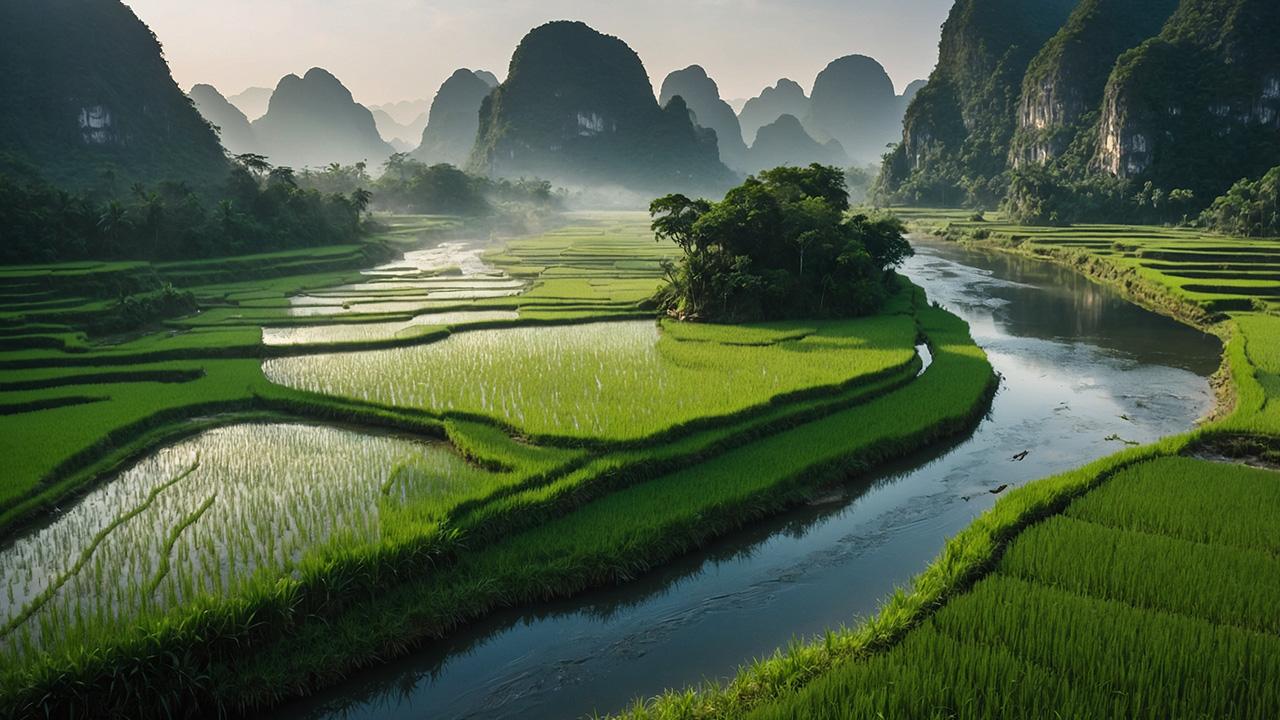
Yet, to leave the comparison there is to see the set dressing but miss the historical drama. While Ha Long Bay was born of the ocean, this is a world born of rivers and rice fields. The towering karsts here do not stand guard over a saltwater bay, but over a labyrinth of tranquil waterways and a patchwork of impossibly green paddies.
This unique geology did more than just create beauty; it forged a nation. For these were not just mountains; they were walls. This was not just a river valley; it was a natural fortress. A place where, over a thousand years ago, a fledgling kingdom declared its independence and laid the very foundation of modern Vietnam. This is Ninh Binh, a place where the land tells a story far deeper than any nickname can capture.
Charting the Course: Your Journey Begins
The journey into this mythical kingdom is surprisingly straightforward. Located just 90 to 100 kilometers south of Vietnam’s bustling capital, Hanoi, Ninh Binh is an accessible escape from the city’s thrum. The trip typically takes between one and a half to two and a half hours, with several options to suit any traveler’s pace and budget.
For a scenic and affordable journey, the train offers a classic Vietnamese travel experience. It glides through the countryside, providing glimpses of rural life before arriving in Ninh Binh city. Tickets are economical, generally ranging from approximately $8 to $12 USD. The most popular option, however, is the modern limousine bus or shuttle van.
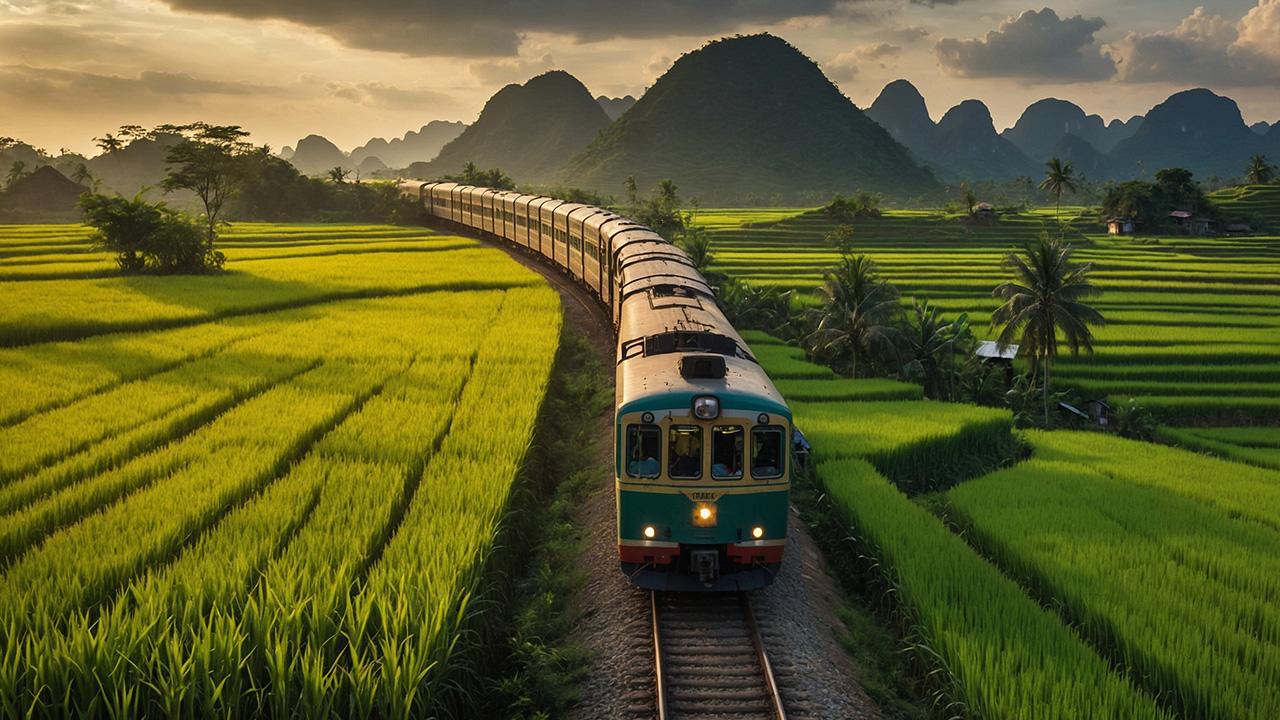
These services are frequent, comfortable, and convenient, often offering hotel pick-up in Hanoi and drop-off in the main tourist areas of Ninh Binh. Fares range from as little as $6 USD for a standard bus to around $15 USD for a premium limousine seat. For those seeking ultimate flexibility, a private car or taxi provides a direct, door-to-door service, though it is the most expensive choice, with prices starting at $60 USD or more.
Upon arrival, the true adventure begins with a choice. A choice between two great waterways, each with its own story, its own rhythm. Will the traveler brave the epic, cinematic labyrinth of Trang An, or drift down the poetic, golden river of Tam Coc? The answer will define the journey through this kingdom on land.
The Two Rivers – A Tale of Two Journeys
The soul of Ninh Binh is found on its water. The experience is defined by a journey on a small sampan boat, rowed by a local guide, through a landscape of unparalleled beauty. However, the region presents a fascinating choice between two distinct, world-class boat tours: Trang An and Tam Coc. This decision is more than a matter of logistics; it’s a choice between two different philosophies of travel, reflecting the dynamic evolution of tourism in Vietnam itself. One represents a highly organized, large-scale, and polished UNESCO experience, while the other offers a more organic, pastoral, and intimate connection to the land and its people.
Trang An: The Labyrinth of Kings
To enter Trang An is to feel as though one is sailing into a lost world. Recognized in 2014 as a UNESCO World Heritage Site—Vietnam’s first “mixed” heritage site, celebrated for both its staggering natural beauty and its profound cultural significance—Trang An is an experience of epic proportions. The landscape is a dramatic tapestry of towering, jungle-clad karsts, vast, serene waterways of emerald, crystal-clear water, and a complex system of caves and grottoes. The history here is ancient; archaeological evidence found within these caves points to human activity dating back over 30,000 years, with early inhabitants using these natural shelters as their homes.
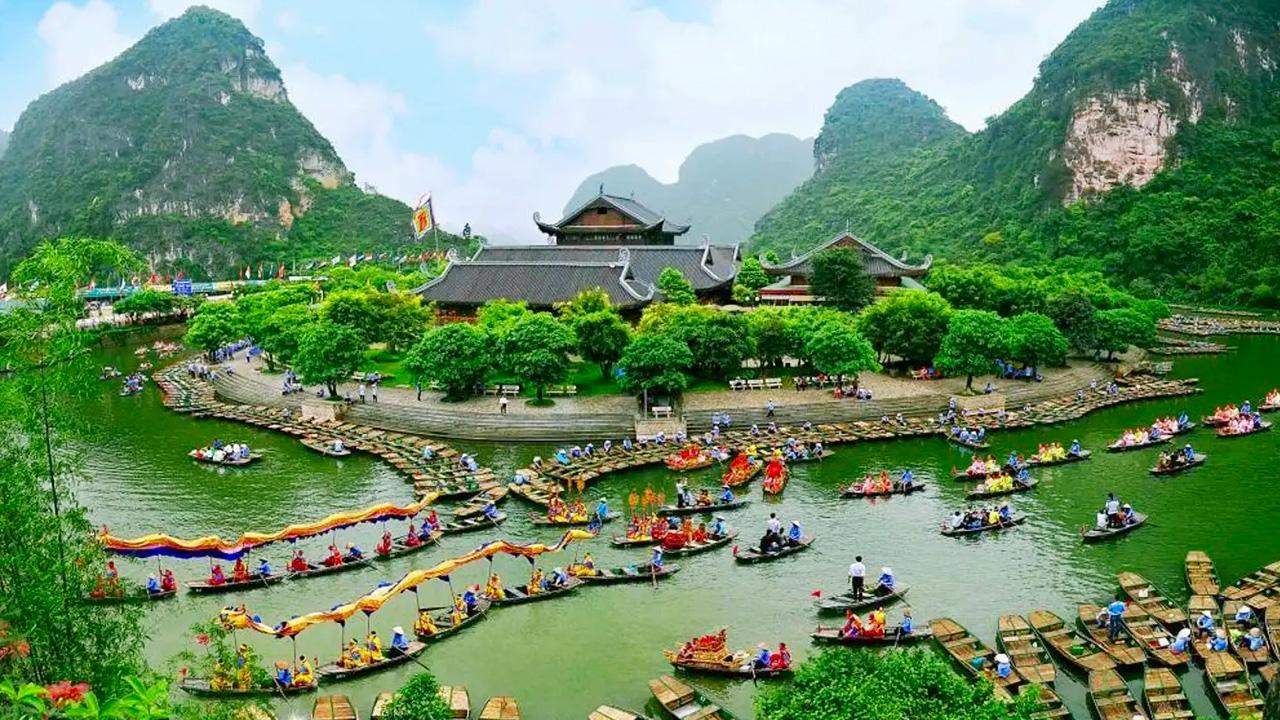
The boat tours are exceptionally well-organized, lasting between 2.5 and 3 hours. Visitors choose from one of several set routes, each offering a different adventure. Route 1 is a cave-lover’s dream, navigating through nine different water caves and stopping at three temples.
Routes 2 and 3 offer a balanced mix of caves, temples, and a journey past the atmospheric film set for the 2017 movie Kong: Skull Island. Gliding through the caves is a highlight; some are short and naturally lit, while others, like the 320-meter-long Thanh Truot Cave, are long, dark, and illuminated by subtle lights, requiring passengers to duck their heads as the boat passes under low-hanging limestone ceilings. The experience is professional and polished, notably free from the hawkers and vendors sometimes found at other sites, though this structure can make it feel more commercialized to some.
Tam Coc: The River of Golden Silk
If Trang An is an epic film, Tam Coc is a lyrical poem. The name translates to “Three Caves,” and the journey here follows the gentle, meandering Ngo Dong River as it winds its way not through vast lakes, but through a valley floor covered in vibrant rice paddies. This is the quintessential image of Ninh Binh: the green or gold of the rice fields, the grey of the karsts, and the blue of the sky, all reflected in the tranquil water. The boat trip is shorter, typically an hour and a half to two hours, following a single out-and-back route through the three main caves: Hang Ca, Hang Hai, and Hang Ba.
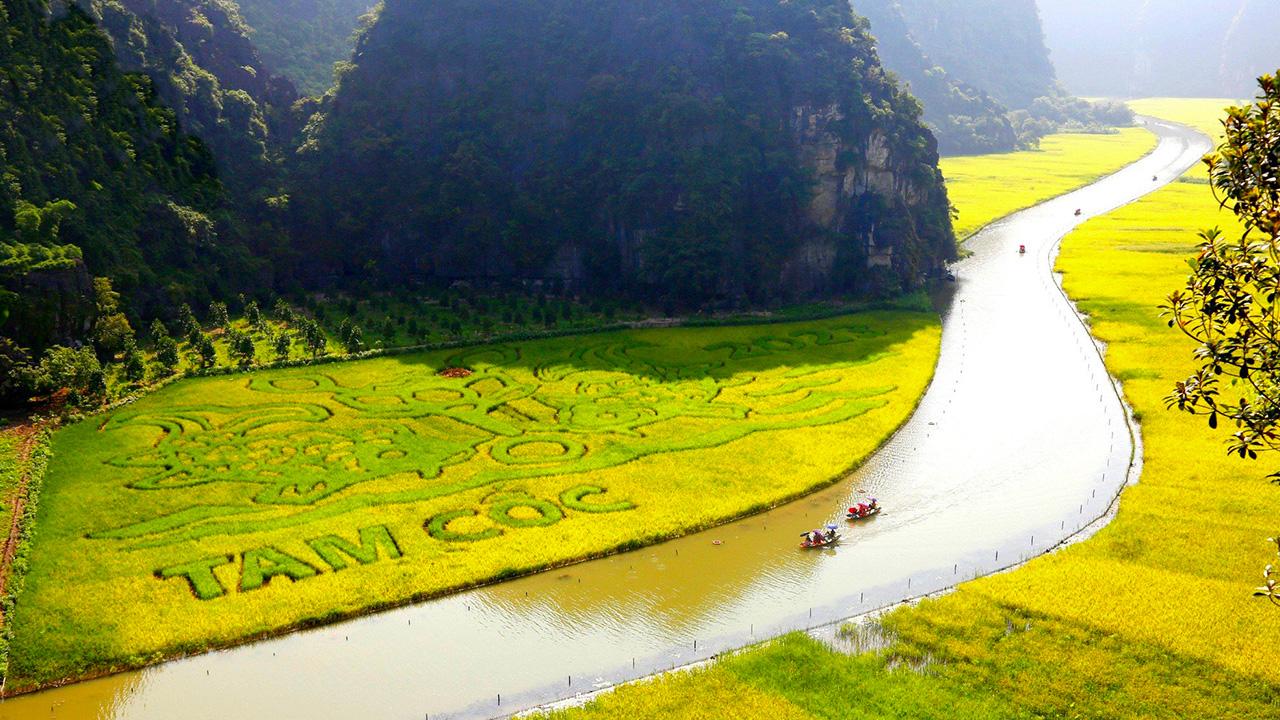
What truly sets Tam Coc apart is its connection to the agricultural lifeblood of the region. The landscape transforms with the seasons, offering two peak windows of beauty. From late April through May, the paddies are a brilliant, lush green as the young rice shoots grow. Then, from late May through early June, the valley turns into a “golden silk carpet” as the rice ripens for harvest, a spectacle of color that photographers and travelers dream of.
The experience is made even more memorable by the local rowers, many of whom are women who have perfected a unique and mesmerizing technique of rowing with their feet, leaving their hands free. Along the way, visitors can admire landmarks like the stunning Bich Dong Pagoda, a series of three temples built into a mountainside, and Thai Vi Temple, dedicated to the kings of the Tran Dynasty. The Tam Coc experience feels more “natural” and “untouched,” but its less-centralized organization means visitors may be approached by vendors on the river.
Choosing between the epic and the poem, the UNESCO labyrinth and the golden river, is a personal decision based on travel style and priorities. Trang An offers a grand, reliable, and diverse adventure on a massive scale. Tam Coc provides a more intimate, pastoral, and culturally unique journey tied to the rhythms of the rice season.
The Dragon’s Spine – A Kingdom Forged in Stone
Beyond the waterways, the land itself rises to tell stories of kings, gods, and dragons. The limestone karsts are not merely a backdrop; they are the very spine of Ninh Binh’s history, home to ancient capitals, sacred pagodas, and viewpoints that touch the heavens.
Hoa Lu: Birthplace of a Nation
A journey to Ninh Binh is incomplete without paying homage to Hoa Lu, the region’s historical heart. From 968 to 1010, this very ground served as the capital of Dai Co Viet, the first centralized feudal state of an independent Vietnam. Its selection as the capital by Emperor Dinh Tien Hoang was an act of strategic genius. After unifying the nation by defeating twelve rival warlords, he chose his homeland of Hoa Lu not for its beauty, but for its defensibility.
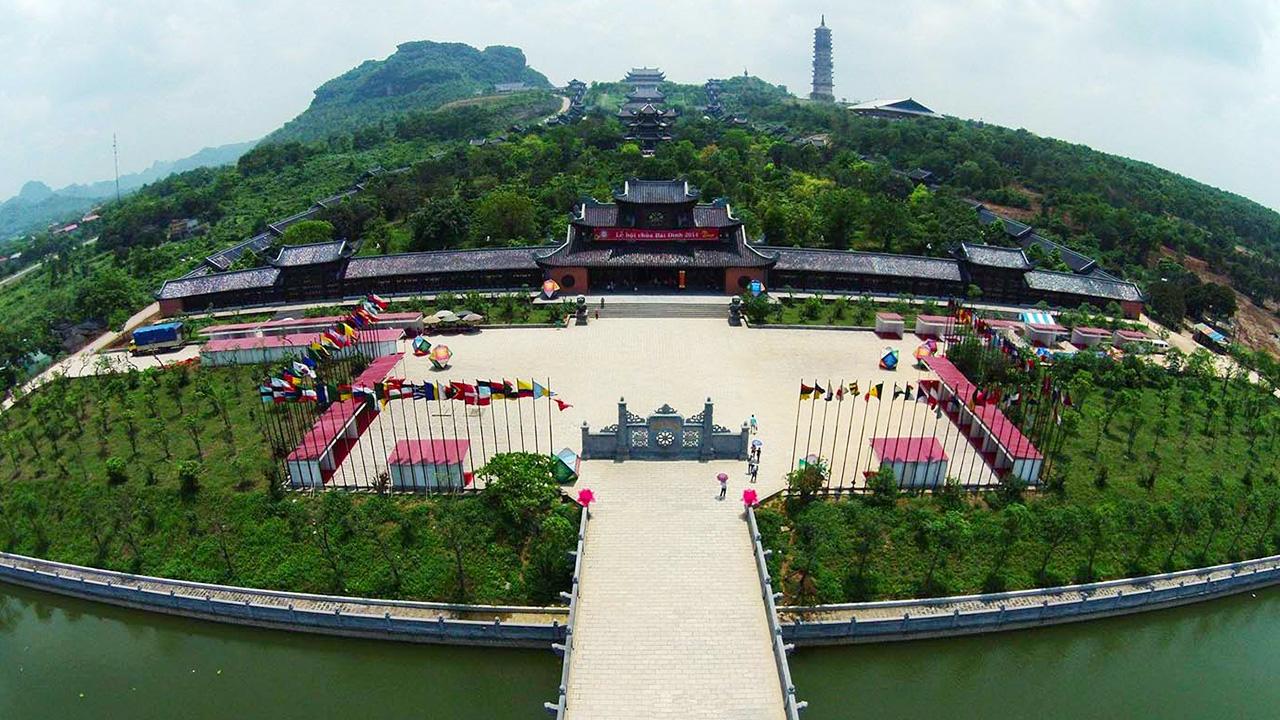
The landscape itself was the fortress. The jagged limestone mountains served as impenetrable walls, and the winding rivers acted as natural moats, creating a citadel so secure it was never breached by an enemy army during its time as the capital. Here, protected by nature, the Dinh and subsequent Early Le dynasties could consolidate power, establish a national identity, and begin the story of a sovereign Vietnam after a millennium of foreign domination.
Though the ancient citadel’s palaces are long gone—the capital was moved to Thang Long (now Hanoi) in 1010—its spirit remains in the serene temples built in the 17th century to honor its founding kings. The Temple of King Dinh Tien Hoang stands on the grounds of his former palace, a beautiful example of traditional architecture featuring intricate wood and stone carvings and a reverent bronze statue of the emperor.6 Nearby, the slightly larger Temple of King Le Dai Hanh commemorates the founder of the Le dynasty, who stabilized the nation and continued its legacy. To walk these grounds is to walk through the cradle of a nation.
Mua Cave (Hang Mua): The Stairway to a God’s-Eye View
For the most breathtaking perspective of Ninh Binh’s beauty, one must ascend. Mua Cave, or Hang Mua, offers just that, via a climb that has become a rite of passage for visitors. A stone staircase of approximately 500 steps zig-zags its way up the side of Ngoa Long Mountain, which translates to “Lying Dragon Mountain”. The climb is a workout, especially in the tropical heat, making an early morning or late afternoon visit highly advisable. The name “Mua Cave” means “Dancing Cave,” stemming from a legend that King Tran Thai Tong of the Tran Dynasty would visit this peak to watch his concubines dance and sing.
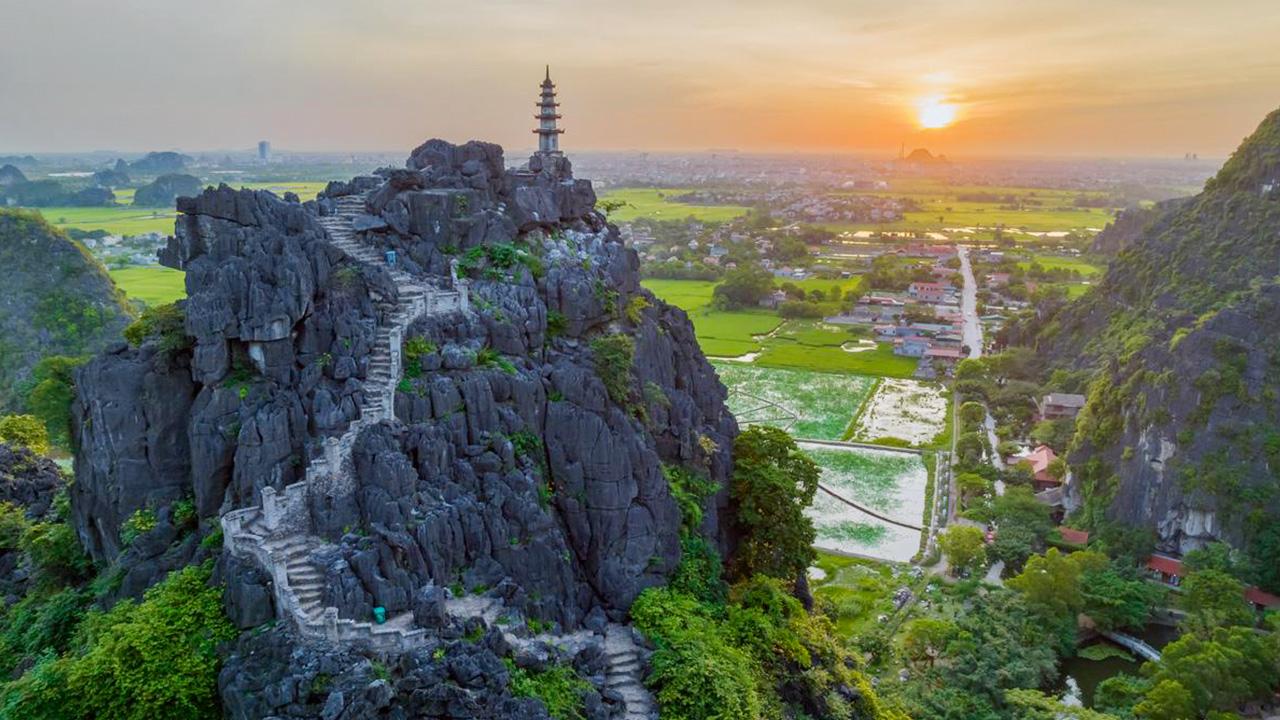
About two-thirds of the way up, the path forks. To the right lies a small, elegant pagoda and a Buddhist stupa offering peaceful views. But the main prize lies to the left. This path leads to the highest pinnacle, where a magnificent stone dragon sculpture snakes along the entire ridgeline, guarding the valley below.
From this vantage point, the reward for the climb is revealed: arguably the most famous panoramic view in Vietnam. The entire Tam Coc valley unfolds below—a tapestry of rice paddies, the winding Ngo Dong river dotted with tiny boats, and a sea of karsts stretching to the horizon. It is a god’s-eye view of the kingdom, a moment of pure, unforgettable awe.
Bai Dinh Pagoda: A Modern Marvel on Ancient Ground
Ninh Binh is a place where different layers of time coexist, and nowhere is this more apparent than at the Bai Dinh Pagoda complex. This site offers a powerful dialogue between Vietnam’s ancient spiritual traditions and its ambitious, modern faith. The complex is split into two distinct areas: the ancient pagoda and the new pagoda. The ancient Bai Dinh Pagoda, dating back to the 11th-century Ly Dynasty, is nestled in caves on a hillside, requiring a climb of over 300 stone steps to reach. It is an intimate, moss-covered sanctuary where Buddhist deities and mountain spirits are worshipped, exuding an aura of timeless tranquility.
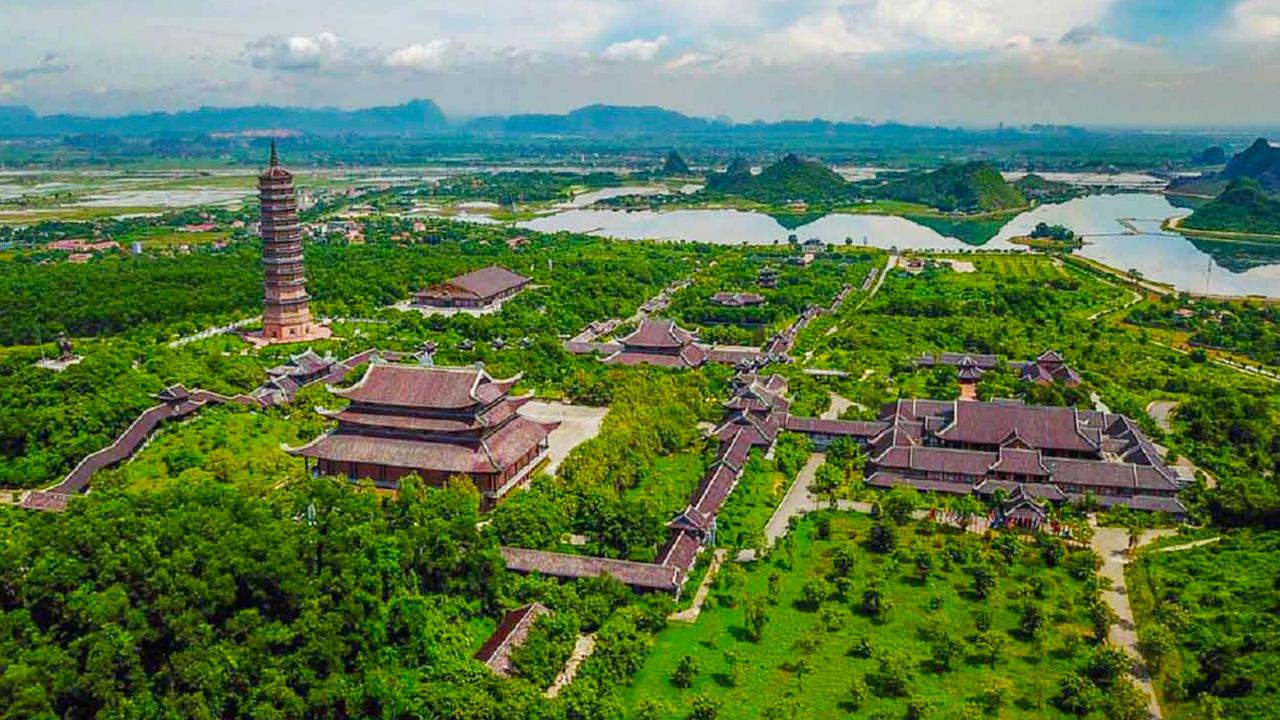
In stark contrast, just a short distance away, lies the new Bai Dinh Pagoda. Constructed between 2003 and 2010, this is a religious complex on a staggering scale, a modern marvel designed to be one of the largest Buddhist centers in Southeast Asia. It is a place of superlatives, holding numerous national and Asian records that attest to its grandeur.35 Visitors can explore:
- The largest Buddhist complex in Vietnam, sprawling over hundreds of hectares.
- The tallest stupa in Asia, the Bao Thap Tower, rising 100 meters and 13 stories high, housing sacred relics.
- The largest bronze bell in Vietnam, weighing a colossal 36 tons.
- The longest Arhat corridor in Asia, a covered walkway stretching over 3 kilometers and lined with 500 life-sized stone statues of Buddhist saints, each with a unique expression.
- The largest bronze Maitreya Buddha statue in Southeast Asia, an 80-ton, 10-meter-high figure seated majestically on a hillside.
Visiting Bai Dinh is to witness the layering of a thousand years of faith, moving from the quiet solitude of an ancient cave temple to the awe-inspiring magnificence of a modern spiritual monument.
The Wild Heart & The Local Flavor
Beyond the temples and historical sites, Ninh Binh is a sanctuary for some of Vietnam’s most precious and endangered wildlife. This commitment to conservation represents a modern, forward-looking identity, positioning the region as a critical hub for biodiversity protection in Southeast Asia. This wild heart, in turn, influences the very flavor of the land, creating a cuisine that is inseparable from its environment.
The Last Sanctuaries: Conservation and Biodiversity
The story of conservation in Ninh Binh begins at Cuc Phuong National Park. Established in 1962, it holds the distinction of being Vietnam’s very first national park, a testament to a long-standing dedication to preserving the country’s natural heritage. This vast expanse of over 22,000 hectares is a treasure trove of biodiversity, a limestone tropical forest ecosystem that is home to over 2,200 species of plants, 135 species of mammals, and more than 330 species of birds.

More than just a protected forest, Cuc Phuong is an active center for critical conservation work. Within the park are several world-renowned rescue centers:
- The Endangered Primate Rescue Center (EPRC): Established in 1993, this center is a crucial lifeline for some of the world’s most endangered primates, including the striking Delacour’s Langur, the golden-headed langur, and various gibbon species, rehabilitating them from the illegal wildlife trade.
- The Turtle Conservation Center (TCC): A sanctuary for Vietnam’s rarest freshwater turtles, this center runs breeding programs for critically endangered species like the Vietnamese pond turtle, which is nearly extinct in the wild.
- The Carnivore and Pangolin Conservation Program (CPCP): This program rescues and rehabilitates small carnivores like civets and otters, as well as pangolins—the most trafficked mammal in the world—playing a vital role in the global fight to save these unique creatures.
Further afield lies Van Long Nature Reserve, a stunningly tranquil wetland designated as a Ramsar site of international importance. Known locally as the “bay without waves” for its mirror-flat water, this reserve of reeds, swamps, and karsts is the single most important habitat for the critically endangered Delacour’s langur. It is the best, and indeed only, place in the world where this primate can be reliably observed in the wild. For the best chance of spotting them on the cliffs, a boat trip in the early morning or late afternoon is recommended.
A Taste of the Mountains: The Terroir on a Plate
The unique geography of Ninh Binh—its limestone mountains, fertile plains, and freshwater rivers—directly shapes its cuisine, creating flavors that cannot be replicated elsewhere. The food here is a true taste of the terroir.
The undisputed star of the local menu is Mountain Goat Meat (Thịt Dê Núi). Unlike goats raised elsewhere, the goats of Ninh Binh are free-range, leaping across the limestone karsts and grazing on the abundant wild herbs and medicinal plants that grow there. This unique diet is believed to give the meat a firm, lean texture and a distinctively sweet, less gamey flavor. It is prepared in many ways, but a local specialty is Dê Tái Chanh, a refreshing “salad” where lightly steamed goat meat is sliced thin and “cooked” with lime juice, then mixed with chili, lemongrass, and herbs.
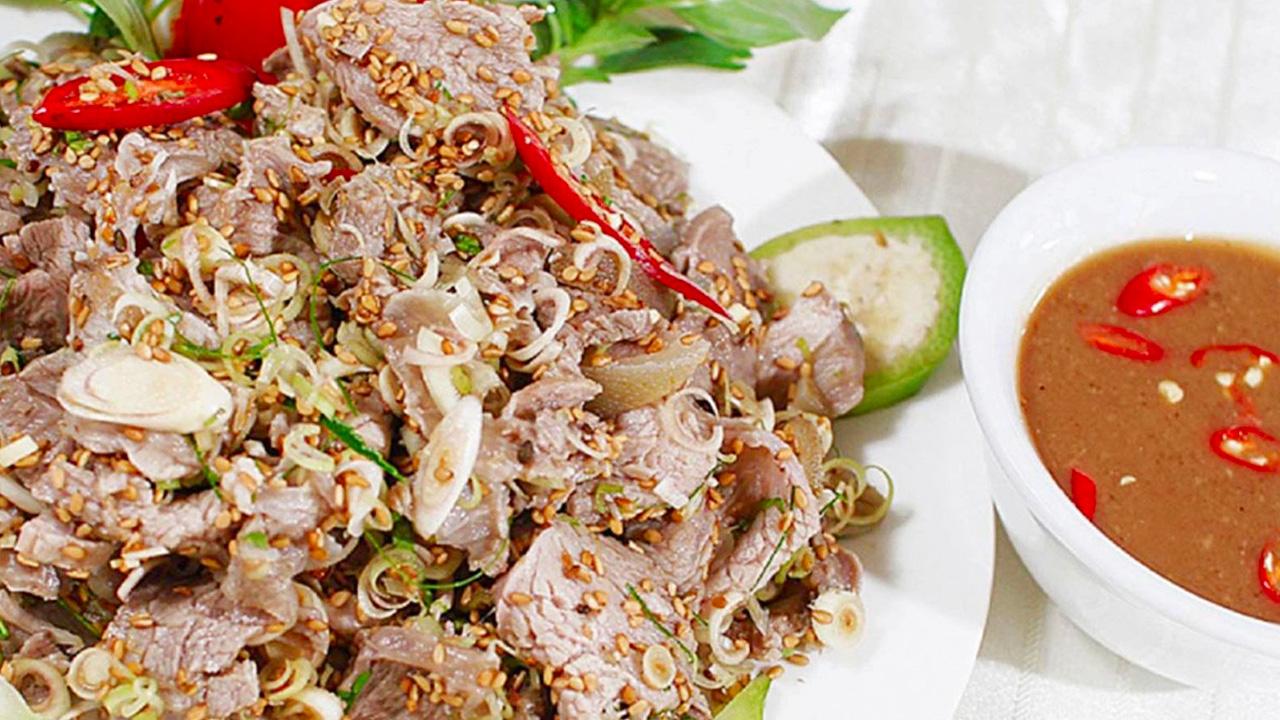
The perfect accompaniment to the goat meat is Crispy Burnt Rice (Cơm Cháy). This iconic snack is a regional specialty, made from glutinous rice that is cooked, pressed flat, sun-dried, and then deep-fried into a golden, crunchy cracker. It is often topped with savory pork floss (chà bông) and eaten as a snack, or used as a crunchy, edible plate for scooping up rich goat stew. Other local delicacies include Mountain Snails (Ốc Núi), which gain a unique herbal flavor from their diet inside the limestone caves, and the potent local Kim Son Rice Wine (Rượu Kim Son).
Your Ninh Binh Story – A Practical Epilogue
With its myriad wonders, from epic waterways to ancient history and rare wildlife, planning a trip to Ninh Binh can seem daunting. But with a little knowledge, crafting the perfect adventure is simple. This final section provides the practical tools to help any traveler write their own Ninh Binh story.
Crafting Your Adventure: When to Go & Where to Stay
Choosing the right time to visit Ninh Binh is crucial, as the experience changes dramatically with the seasons. The decision often involves balancing ideal weather with the all-important rice harvest cycles in Tam Coc. The following guide synthesizes weather patterns, agricultural seasons, and local events to help visitors choose their perfect window.
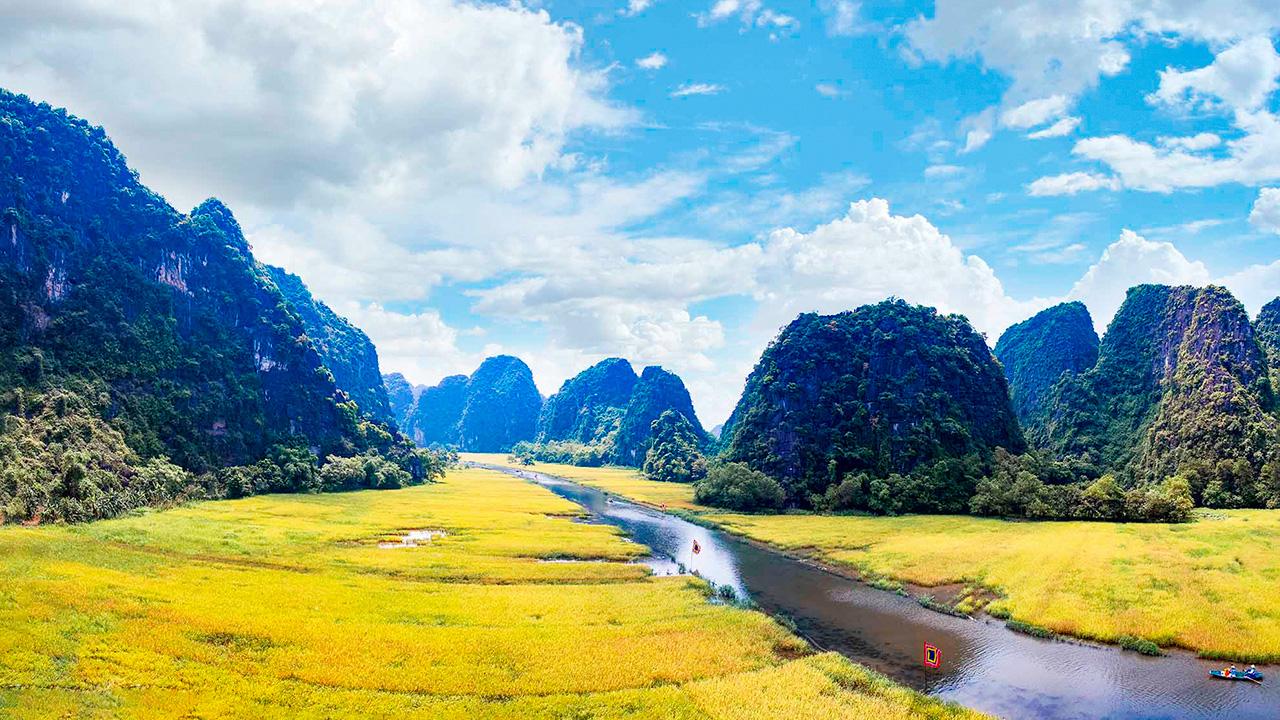
January – March: Tranquil Spring and Spiritual Journeys
From January to March, Tam Coc welcomes visitors with cool, dry, and pleasant weather, averaging 18–24°C. While the rice fields are either recently harvested or in early planting stages—so the landscape may not be at its most scenic—this period is rich in cultural and spiritual experiences. It’s also festival season in Vietnam, featuring major events like Tet (Lunar New Year) and the Bai Dinh Pagoda Festival, one of the largest Buddhist festivals in the country.
Recommended activities: temple visits, spiritual exploration, gentle hiking, cultural discovery.
April – June: The Golden Season – Tam Coc at Its Most Beautiful
This is when Tam Coc reveals its most breathtaking beauty. From April to early May, the rice fields are lush and green, then gradually turn into brilliant golden carpets by late May through June, just before harvest. Though the temperature rises (up to 35°C), the reward is a visual masterpiece, attracting photographers, nature lovers, and travelers seeking Vietnam’s rural charm at its finest.
Recommended activities: boat tours along the Ngo Dong River, Mua Cave climb for panoramic views, photography during sunrise and sunset.
July – September: Rainy, Green, and Ideal for Budget Travelers
These months are the hottest and most humid, with frequent rain. However, the rain brings a vibrant green to the rice fields, offering a fresh and peaceful atmosphere. As tourist numbers drop, prices go down too—making it a great time for travelers who don’t mind the occasional shower and prefer a quieter experience.
Recommended activities: peaceful boat rides, local village visits, off-the-beaten-path exploration.
October – December: Golden Autumn and Outdoor Adventures
The end of the year offers mild, dry, and comfortable weather—perfect for outdoor exploration. You may also catch the second rice harvest in late September or October, adding a golden glow to the scenery once again. With fewer rains and crisp air, this season is ideal for cycling, hiking, and simply enjoying Tam Coc’s countryside charm.
Recommended activities: biking along scenic rural routes, hiking to Mua Cave, boat tours through serene landscapes.
Travel Tips at a Glance
- For the most stunning views of rice fields, visit in late May to early June or late September to early October.
- For fewer crowds and lower prices, July to September is your best bet.
- For cultural festivals and spiritual experiences, plan your trip during January or February.
For accommodation, it is highly recommended to stay in the scenic areas of Tam Coc or Trang An rather than in Ninh Binh city itself, to be fully immersed in the region’s tranquil atmosphere. The area offers a wide range of options. There are charming, budget-friendly homestays built from bamboo and nestled among lotus ponds and mountains, such as Nguyen Shack Ninh Binh and Lotus Field Homestay.
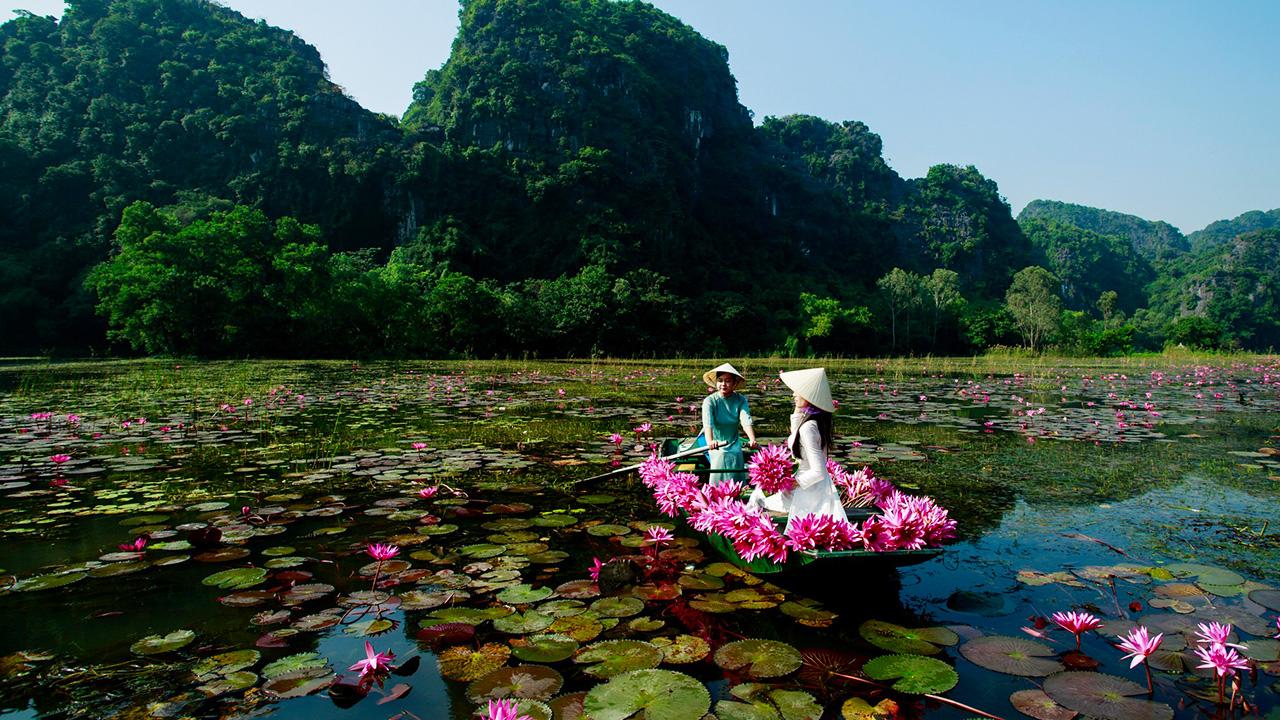
For more comfort, numerous mid-range hotels and luxurious resorts like the Emeralda Tam Coc and the Hidden Charm Resort offer premium amenities and stunning views. For those seeking deeper cultural immersion, a visit to one of the region’s traditional craft villages, like the Van Lam embroidery village or the Kim Son sedge mat weaving village, offers a glimpse into centuries-old artisanal traditions.
The Echo of the Karsts: A Final Reflection
Ninh Binh is more than a destination; it is a conversation. A conversation between the past and the present, between humanity and the earth that shaped it. It is a story heard in the gentle echo of an oar on the water, felt in the cool air of a thousand-year-old cave, and tasted in the flavor of the mountains in a simple meal. It is a place that rewards the curious, inspires the artist, and rejuvenates the soul. This is a story written in stone, water, and rice—a story that is waiting for new travelers to come and read its next chapter.
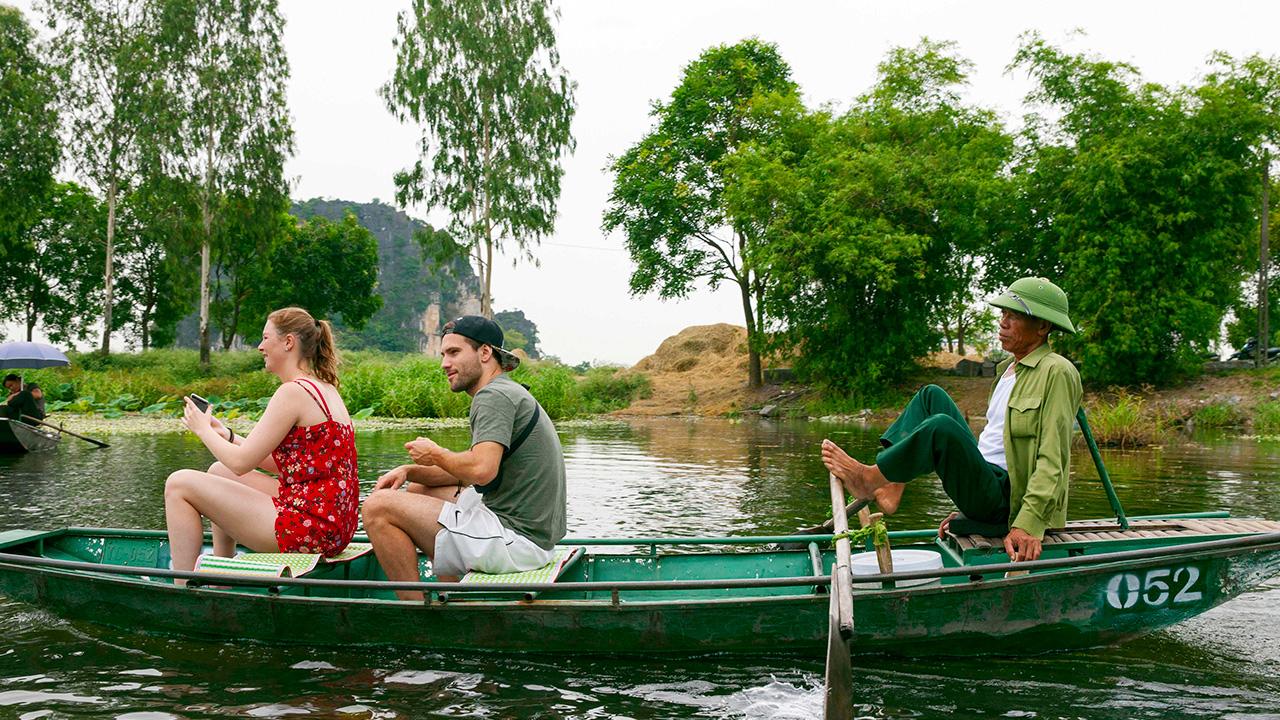
Conclusion
Ninh Binh is not just a destination—it’s an experience that touches the heart and soul. From the tranquil boat rides in Trang An to the panoramic views from Hang Múa, every corner of this province tells a story of Vietnam’s rich natural and cultural legacy. Whether you’re planning a quick day trip or a peaceful weekend getaway, Ninh Binh will reward you with memories that linger long after you’ve returned home.
So pack your bags, charge your camera, and get ready to uncover the timeless beauty of Ninh Binh!


